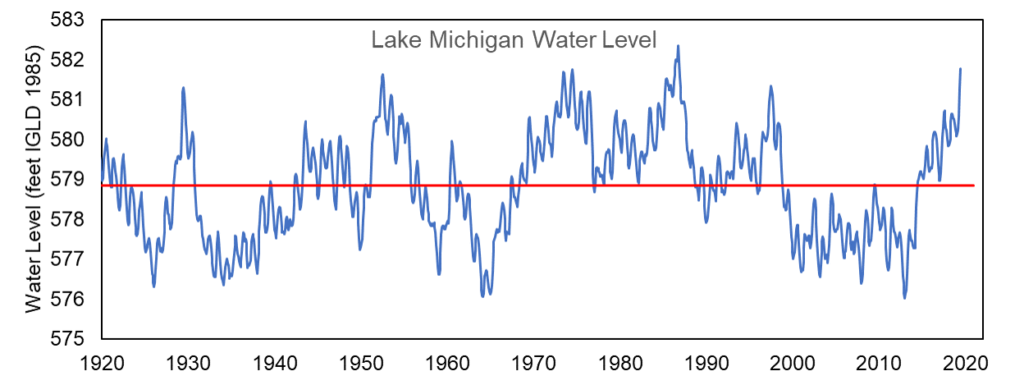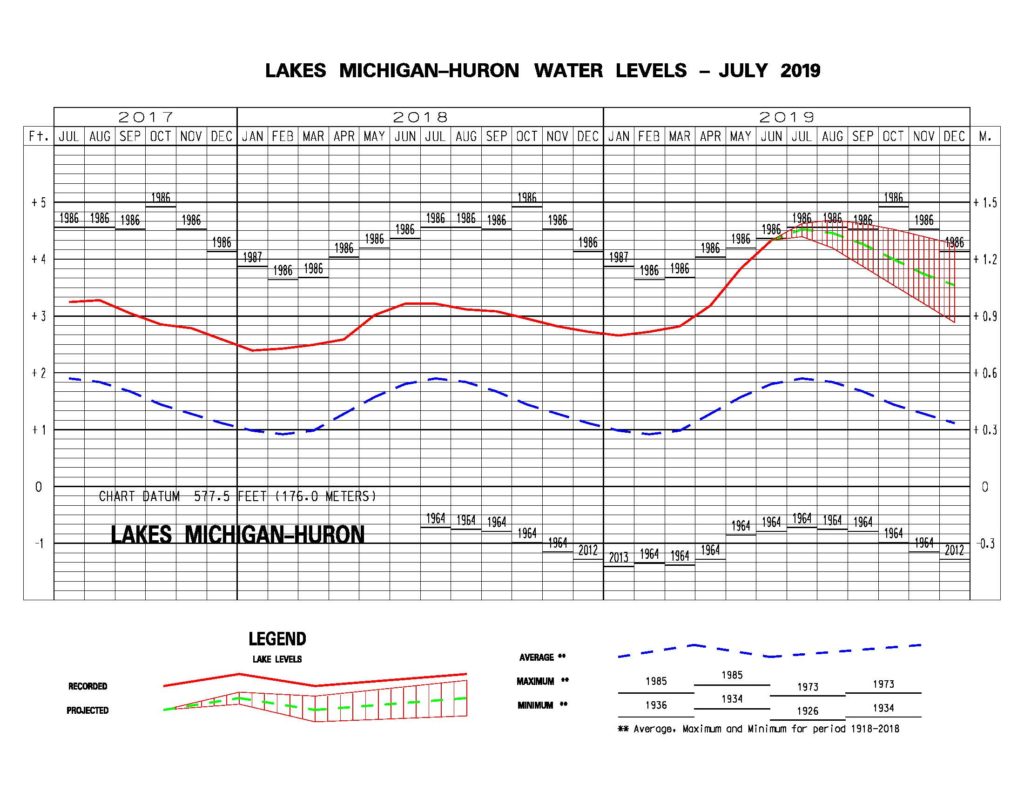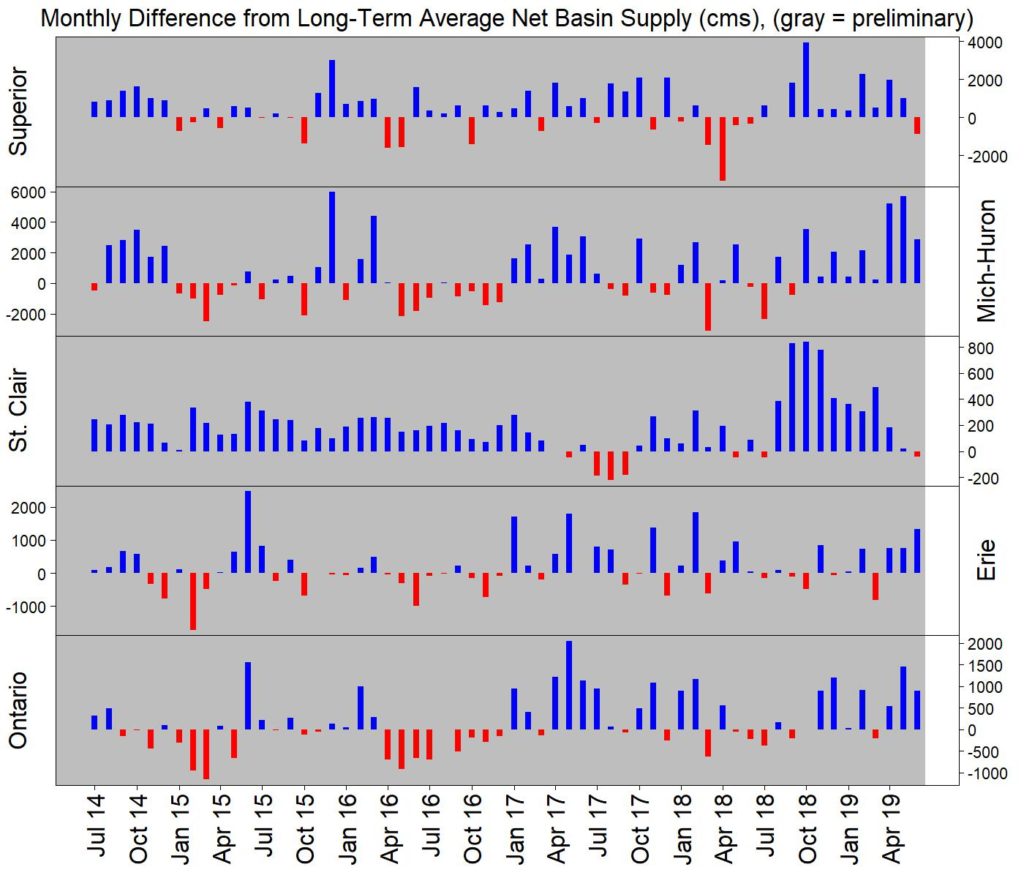
July 8, 2019
By Adam Bechle, Coastal Resilience Outreach Specialist, Wisconsin Sea Grant
The water levels on all of the Great Lakes are very high, with every lake at or above its record high monthly mean for July. Looking back at the month of June 2019, Lakes Superior, Erie, and Ontario all broke their record high monthly mean for June. Lake Michigan-Huron just barely missed setting a new June record monthly mean by half an inch (0.04 feet).
Here are five things to know about water levels on Lake Michigan for July 2019.
What are the current water levels on Lake Michigan?
The water level of Lake Michigan as of July 5, 2019 is at an elevation of 581.92 feet above sea level (from the International Great Lakes Datum). For the most current daily water level, click here. To put this level into perspective, here are some statistics for Lake Michigan relative to the period of water level record measured from 1918 to 2018: (statistics from U.S. Army Corps of Engineers Weekly Water Level Update)
| Compared to… | Current Water Levels are… |
| One month ago | 4 inches higher |
| One year ago | 15 inches higher |
| Average July (from 1918 to 2018) | 31 inches higher |
| Record July monthly mean (set in 1986) | 1 inch below |
| Record high for any month (set in October 1986) | 5 inches below |
What is the outlook for future water levels?
The US Army Corps of Engineers projects Lake Michigan to remain near record high levels for the foreseeable future (see six-month forecast issued for July 2019 below). Water levels are expected to continue to rise through July and August, with a projected rise of about 2 inches by August 5th, 2019. A slight decrease in water levels is expected throughout the fall and winter as precipitation and runoff into the lakes typically decreases and evaporation from the lakes increase. In an average year, water levels vary seasonally by about one foot from a peak in summer to a low in winter, though every year is different. Water levels would be expected to begin a seasonal rise again next spring when runoff and precipitation increase.

Six month water level forecast for Lake Michigan issued July 2019. Source: U.S. Army Corps of Engineers – https://www.lre.usace.army.mil/Missions/Great-Lakes-Information/Great-Lakes-Water-Levels/Water-Level-Forecast/Monthly-Bulletin-of-Great-Lakes-Water-Levels
Why are lake levels so high?
In short, the water supply into the Great Lakes has been quite high. The Great Lakes as a whole has had above average precipitation this spring and so far this summer. For the Lake Michigan watershed, precipitation was above average for in April (+ 30% above average), May (+31%), and June (+13%). These wet conditions have been a large contributor to the recent rise in lake levels in the past few months.
But precipitation is not the only contribution to lake level change, as water also enter the lake through runoff and leaves the lake through evaporation. To account for this, we turn to Net Basin Supply, which is calculated as
Net Basin Supply = Precipitation + Runoff – Evaporation
In general, when Net Basin Supply is positive, more water enters the lake than leaves, yielding a rise in lake levels. A five-year history of the measured Net Basin Supply is shown below, where blue indicates a positive Net Basin Supply and red is a negative Net Basin Supply. As a whole, the Great Lakes has seen a lot more blue than red in the last five years, indicating a consistently positive Net Basin Supply which has driven our high lake levels. The Net Basin Supply of Lake Michigan specifically has been above-average for the nine consecutive months, with big spikes in April and May of 2019. The result is our high lake levels.

Net Basin Supply to the Great Lakes, where blue indicates a positive NBS and red is a negative NBSSource: US Army Corps of Engineers – http://lre-wm.usace.army.mil/ForecastData/GLBasinConditions/monthlyNBSPast5Years.jpg
How do high lake levels affect the coast?
High water levels present many challenges that are currently being felt throughout the Great Lakes, including:
- High water levels allow erosive waves to reach higher elevations on the shore where they batter shoreline infrastructure and eat away at the base of bluffs and dunes
- In low-lying coastal areas, high water levels can also make coastal flooding in low-lying coastal areas more likely
- In ports and harbors, high water can cause operational and safety issues if a large elevation difference exists between vessel and dockage
See our Coastal Hazards page for details about these impacts.
Where can I go for more information?
Our Resilience Resources webpage has links to many resources on dealing with issues related to water level fluctuations, including Adapting to a Changing Coast:Options and Resources for Lake Michigan Property Owners (pictured right)
The NOAA Lake Level Viewer is a web-based, interactive map used to help users visualize potential Great Lakes water level changes and impacts. For more information, check out our Resource of the Month feature here.
Great Lakes Water Budgets from the University of Michigan gives a bit more information into what makes the lakes go up and down
The US Army Corps’ Great Lakes Information page has tons of details on water levels. For more information, check out our Resource of the Month feature here.






